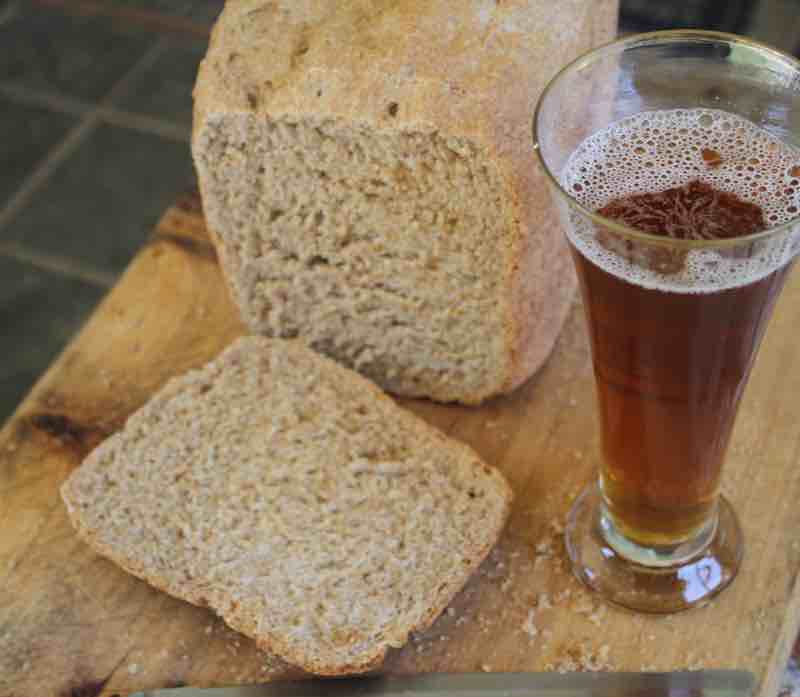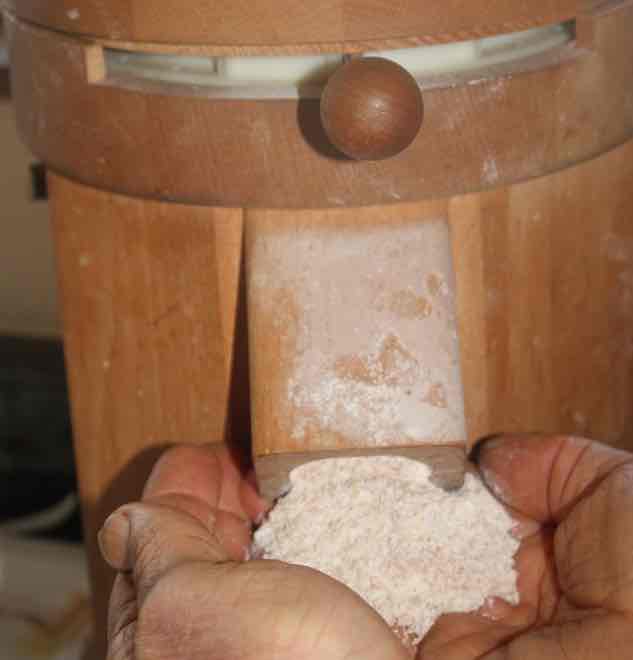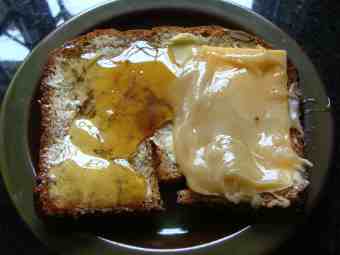- Bernard Preston homepage
- Bread
- Yeasted Beer Bread
Yeasted beer bread
Yeasted beer bread using 100% wholegrain-flour is not difficult to make. It takes less than ten minutes to grind the wheat and mix the dough; and then another five hours to prove and bake.
Beer and bread make a natural fit since both are based on grains that are fermented with yeast; the one using barley and the other wheat.
Using a sourdough culture will further make this an interesting loaf for those who love to experiment; the bacteria predigest the protein, dealing with the gluten-issue that some have. All the research though suggests this is greatly exaggerated.

It is the chemicals that commercial-bakers use that cause most of the bloating and discomfort.
Certainly
for those suffering from Coeliac-disease it is a real concern; but the
discomfort that the majority experience has more to do with an
inadequate microbiome, and less of a true allergy. Do you have pain after eating commercial bread? You will find the homebake quite different.
Ingredients
- 600 grams of freshly ground 100% wholewheat-meal, or the best you can get.
- 2 large scoops of sourdough-culture.
- 300 ml beer.
- 1 tsp fine-salt.
- 1 TBSP honey.
- 1 TBSP of butter.
- 1 tsp dry-yeast.
- Add the butter, honey and beer to the baking-tin; and the salt.
- Add the flour.
- Twirl the paddle to mix.
- Allow to stand for a period; more about that below.
- Sprinkle a tablespoon of partially-refined flour over the dough.
- Sprinkle the dried-yeast over that flour.
- Place in the bread oven; choose the 5-hour setting.
A gluten allergy is a real concern for some; the large amount of proline, an amino acid with a ring-structure unlike all the others, makes for strong bonds which some digestive systems have difficulty breaking down.
The net result is the absorption of short chains of amino acids which are targeted as unknown proteins by their immune systems; the 33-mer peptide is the most common fly in the ointment. Durum flour, emmer and einkorn do not contain it but most other wheat and spelt grains do[2].
For those who have no gluten issues, no standing and waiting-period is necessary; go right ahead and bake.
For those with true gluten allergies, up to 24 hours of predigestion of the flour-protein by the sourdough culture makes it likely that even those suffering from Coeliac disease may be able to enjoy yeasted beer bread[1].
Some may have to avoid the use of common-wheat altogether.
Your yeasted beer bread will have a dark mahogany-looking chewy crust depending on what brew you use. This loaf was made with our own brown honey braggart.
Remove the oven dish carefully from the machine and always allow it to stand for a few-minutes. Using gloves, carefully shake the inverted container; the loaf should slide out.
On this point when washing make sure that every bit of dough is cleansed from the baking-tin; otherwise the loaf will stick and be difficult to remove.
Make sure the paddle has come out, and is not still embedded in the loaf. If so remove it immediately; I use a hooked crochet-stick.
Be very careful not to scratch either the baking-dish or the paddle; no sharp instruments.
If the loaf sinks in the middle, try adding a little less liquid, more butter and only half a teaspoon of dried yeast; it will not affect the rich beer bread flavour but doesn't please the eye so much. Using cold beer to slow the fermentation may also help.
For those who love to get their fingers sticky and knead the dough this Epicurious yeasted beer bread recipe[3] should work fine. Two-hours of hard labour as against five to ten minutes; I remain unconvinced that nutritionally it is any better.
It is good exercise for the arms and shoulders for those who have the patience and time on their hands. Using a conventional oven requires a lot more electricity. Why is whole grain better?
Yeasted beer bread
Yeasted beer bread is no more difficult to make than any other loaf; we use only 100% wholemeal. It means having your own mill but the flour is then a quarter of the cost of the best commercial you can find. This is really just a variation of our artisan recipe.
Your own mill is a big investment but it soon pays itself off; mine is 30-years old and still going strong every single day.
We use nothing other than 100 percent real flour; a quarter of the price and umpteen times more of the good stuff. Just the lignans that help prevent breast tumours and the vitamin E that is a natural anti-coagulant make it worth your while to go to this extra trouble.

Owning this baby means I can bake the best-bread in the world for less than half a dollar every day. Why is whole grain better is a question you should consider. We could never go back to the commercial loaf; in comparison it tastes like cardboard.
Could you enjoy your regular loaf with no cheese, ham or jellies? I almost never put anything other than butter on our yeasted beer bread. A little natural honey and cheese occasionally is tempting.
I hope you are now beginning to realise there is real and fake bread; once you've tasted this yeasted beer loaf you'll realise they are chalk and cheese. Bake it in your own home and it need not be expensive.
Start to enjoy more fibre from your food; that means in part 100% whole-grain bread, before the real pain of diverticulitis[4] starts to bite. It is usually worse on the left side of the abdomen and is very tender to the touch.
Carbs galore
Despite the opinions of many experts I'm convinced for myself at least that whole grains do not cause me to gain weight. In the summer we have carbs galore to choose from at our green home, so we just drink more beer and less yeasted bread.
But let's face it, whole grains are quite difficult to get. Corn on the cob is the big exception; brown rice too.
It's important for those who love their carbs to learn about resistant starch; why some are so glycemic and how food-preparation radically changes the GI.

- Sourdough Bread Made from Wheat and Nontoxic Flours and Started with Selected Lactobacilli Is Tolerated in Celiac Sprue Patients
- Quantitation of the immunodominant 33-mer peptide from α-gliadin in wheat flours. Web: https://www.nature.com/articles/srep45092
- Yeasted Beer Bread recipe @ Epicurious
- Symptoms of diverticulitis @ WebMD
When browsing use right click and Open Link in New Tab, or you may get a bad gateway signal.
Newsletter
Our newsletter is entitled "create a cyan zone" at your home, preserving both yourself and Mother Earth for future generations; and the family too, of course. We promise not to spam you with daily emails promoting various products. You may get an occasional nudge to buy one of my books.
Here are the back issues.
- Lifestyle and ideal body weight
- What are ultra-processed foods?
- Investing in long-term health
- Diseases from plastic exposure
- Intensive lifestyle management for obesity has limited value
- A world largely devoid of Parkinson's Disease
- The impact of friendly bacteria in the tum on the prevention of cancer
- There's a hole in the bucket
- Everyone is talking about weight loss drugs
- Pull the sweet tooth
- If you suffer from heartburn plant a susu
- Refined maize meal and stunting
- Should agriculture and industry get priority for water and electricity?
- Nature is calling
- Mill your own flour
- Bake your own sourdough bread
- Microplastics from our water
- Alternative types of water storage
- Wear your clothes out
- Comfort foods
- Create a bee-friendly environment
- Go to bed slightly hungry
- Keep bees
- Blue zone folk are religious
- Reduce plastic waste
- Family is important
- What can go in compost?
- Grow broad beans for longevity
- Harvest and store sunshine
- Blue zone exercise
- Harvest and store your rainwater
- Create a cyan zone at your home
Did you find this page interesting? How about forwarding it to a friendly book or food junkie? Better still, a social media tick would help.
- Bernard Preston homepage
- Bread
- Yeasted Beer Bread
Address:
56 Groenekloof Rd,
Hilton, KZN
South Africa
Website:
https://www.bernard-preston.com